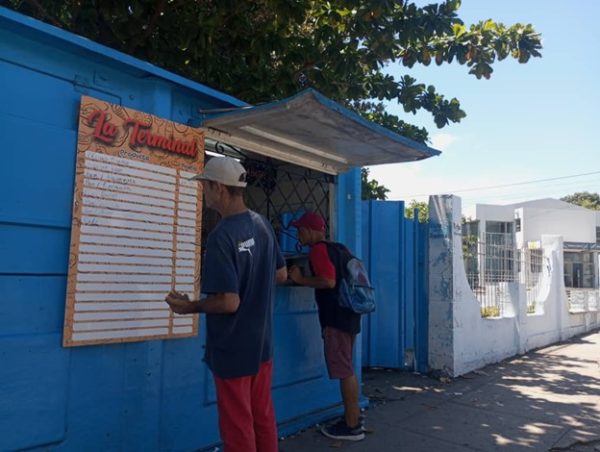in the face of high prices and shortages

Cienfuegos, Cuba resident: “Our diet is terrible, we eat whatever we can get hold of and not what our bodies need.”
By Julio César Contreras (14ymedio)
HAVANA TIMES – When the midday sun heats up the streets of the city, dozens of Cienfuegueros go in search of something light to eat, for the lowest possible cost, to help them “endure” the rest of the day until their evening meal. Others don’t even have this possibility, because of the restrictions of their meagre income. And some even have to resort to begging in order to feed themselves. Still others hardly even manage to get a soft drink or a little water at lunchtime in order to hydrate themselves in the intense heat.
“Until last year, you could get an individual pizza in that place for 60 pesos. But a private owner took over and now the cheapest one costs 150 pesos”, says Arelis, 54, who has just walked past the pizzeria on Calle 37 in the city centre Prado district. “How many of them can I eat in a month if I earn 2,800 pesos? And in the bar next door a croquette roll costs 80 pesos and no one is buying”, she says.
The woman says she’s tired of having to eat pizza all her life. “The average Cuban’s diet is terrible. We eat whatever we can get hold of and not what our bodies need. At home we spend the whole month stretching out a bit of rice, or beans, or chickpeas, or whatever turns up”, she says. Like her, the majority of Cienfuegueros who spoke to us told us that they always have to make a choice between lunch or dinner, whether it’s because they can’t afford both or because the food isn’t available.
Until recently, Arelis’s mother sorted out her lunch in a social security canteen but the establishment shut some months ago for repairs and there’s no date given for its reopening. “I live very near to the ring road and work in the centre near Martí Park, which means that although I would like to, I can’t go home for lunch”, Arelis explains. “So I have to eat whatever I can find, as long as it’s not beyond what I can afford”.
Several people pass down Calle 54, hoping to find something affordable to eat. “The only thing I had this morning, before I left the house, was a sip of coffee. I have two children and what little there is has to go to them, including their snacks now that school has started”, says Nora, a well known university professor who, nonetheless, confesses to 14ymedio that she has to go hungry and forego all kinds of necessities. Her salary isn’t enough, but she’s not allowed to teach private lessons.
“I come every day from Lajas to work. I leave at five in the morning, most of the time without breakfast. Throughout the day all I’ll have is some bread with some kind of filling, or an ice cream cone. By seven in the evening I’m exhausted”, says Jorge, who’s about to retire. “I never thought that after sacrificing so much I’d be seeing myself in this situation. And what’s worse is that they keep on asking me for more sacrifice. How long can this go on?”
“Until a few years ago I could go out to eat with my family. Sometimes we used to go to La Covadonga, over there in La Punta, and we had a lovely time. All that’s gone now”, says the man. And he adds that on an average salary he can only afford to buy the basics for a week or two at most. “And what then? Where will the meat and veg come from, as well as the other basic things? No one can survive like this”.
In any given cafeteria, whether it be on Calle San Carlos, Calle Santa Clara or on Calle Industria, a sandwich can cost at least 150 pesos and it doesn’t matter the type of place that sells it, or the quality of the product. “I feel sorry for my kids because they arrive home from school desperate to eat something and I have to throw something together from the manky bread that we get with the rations and add some filling to last them until dinner time with at least something in their stomachs”, Nora explains.
She and her family have been forced to stop using dairy milk because they can’t pay the price charged at the independent shops. “It’s criminal what we’re going through. I feel like we’re slowly dying”, says the professor as she watches a group of foreign tourists having lunch in Hotel La Unión, part of the Spanish Meliá chain. “At this time my kids have to have just a small yogurt and some yellow rice left over from last night. I think there are no words that can express this”, she says.
The food crisis in Cienfuegos doesn’t discriminate among people, says Arelis: “Hunger doesn’t care about the colour of your skin here, nor about the level of your intellect. You’ll see well dressed people that haven’t had a bite to eat all day”. In Cienfuegos it’s common to see independent restaurants open at all hours with doormen who wait in vain for consumers to walk in. Whilst the menus display attractive dishes with eye-watering prices, people pass by at a distance wondering what they might be able to concoct for their dinner.
Translated by Ricardo Recluso for Translating Cuba.
Read more from Cuba here on Havana Times.